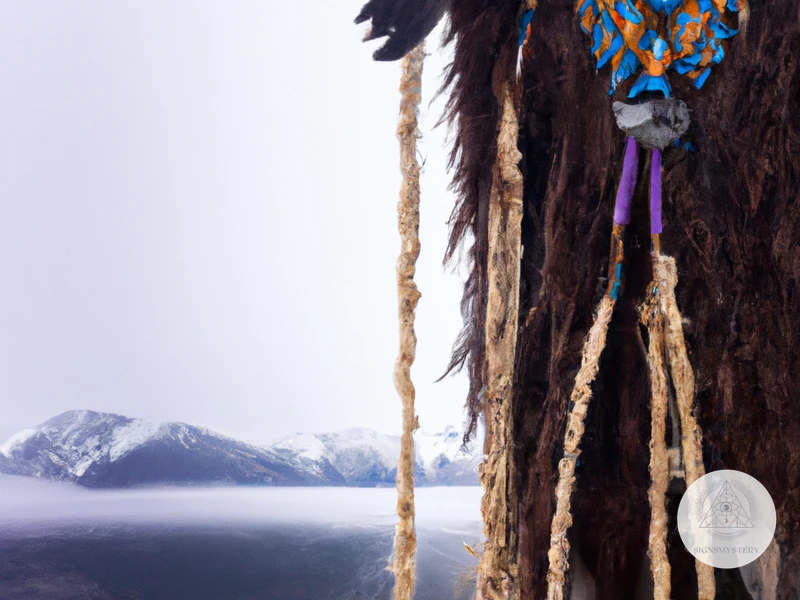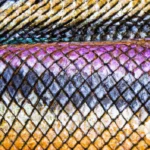Shamanic practices have been around for centuries, and they involve connecting with the spiritual realm to gain guidance, healing, and transformation. Animal spirits play a significant role in shamanism, as they are seen as powerful guides that can provide wisdom and insight. Fur and pelts are also commonly used in shamanic rituals and ceremonies, but what is the connection between animal spirits and these physical objects? In this article, we will explore the fascinating link between animal spirits and fur/pelts in shamanic journeying, including their historical significance, spiritual significance, and ethical considerations. Join us on this journey to discover how connecting with animal spirits through fur and pelts can help deepen your spiritual practice.
What is Shamanism?

Shamanism is a spiritual practice that has been used for centuries by indigenous cultures around the world. It is based on the belief that everything is interconnected and that everything has a spirit or energy. Shamanism involves communicating with spirits and using various techniques, such as chanting and drumming, to journey to other realms or dimensions. In shamanic belief, animal spirits play a significant role as guides and helpers, providing insight and wisdom to those who seek their guidance. The use of fur and pelts in shamanic rituals is also common, with historical significance and spiritual connections between the shaman and the animal. For further information about the role of animal fur symbolism in Shamanism, please follow this link.
The role of animal spirits in shamanic belief
In shamanic belief, animal spirits play a vital role as guides for shamans in their spiritual practices. This spiritual connection between the shaman and animal spirits is based on the belief that animals possess certain qualities that humans can learn from and use to enhance their own spiritual journeys. Animal spirits are believed to have a unique ability to communicate with humans on a spiritual level and can provide guidance, assistance, and protection during shamanic practices. This is why the shaman often seeks help from animal spirits before engaging in a journey.
Shamans believe that each animal spirit possesses different qualities and energies that can be harnessed by humans to achieve specific goals. For instance, if a person wants to gain courage, they may seek the guidance of a lion spirit. Similarly, if someone wants to learn patience, they may seek guidance from a turtle spirit. Shamans believe that through the guidance of animal spirits, it is possible to gain a deeper understanding of oneself and one’s purpose in life.
In shamanic belief, animal spirits are also seen as protectors. Shamans believe that when they journey into the spiritual realm, they are vulnerable to negative energies and entities. They call upon the protective powers of animal spirits to ward off any negative energy that may come their way. The belief is that animal spirits have a powerful ability to repel negative energy and ensure the safety of the shaman during their journeys.
The role of animal spirits in shamanic belief is multi-faceted. They are seen as guides, teachers, protectors, and companions in the shamanic journey. The belief in the spiritual connection between humans and animals has been an integral part of shamanic practice for centuries, and it continues to be an important aspect of modern shamanism.
Use of fur and pelts in shamanic rituals
In shamanic rituals, the use of fur and pelts is common and has significant symbolism. The use of fur and pelts is believed to connect the shaman with the animal spirit, which is considered to be a powerful guide and teacher. The animal spirit guide may assist in healing practices, spirituality, and journeying. Fur and pelts are used in shamanic rituals to honor the animal and show gratitude for their spiritual assistance.
Many shamanic practitioners wear fur and pelts as a part of their attire during ceremonies. These may include headdresses, jackets, capes, or other garments. The specific animal chosen for the fur or pelt is thought to represent the shaman’s connection to that animal and its unique qualities. For example, wolf pelts may be worn to symbolize the shaman’s connection to the wolf’s fierce loyalty and pack mentality.
The use of fur and pelts in shamanic rituals is not just limited to clothing; they can be used in various shamanic tools such as drums, rattles, and medicine bags. The spiritual power of the animal is believed to be transferred to the tool, making them an even more potent aid in shamanic practices.
It is essential to note that there are ethical considerations when using fur and pelts in shamanic rituals. Ethical sourcing and honoring the animal’s spirit are critical. Many shamanic practitioners follow traditional rituals of using every part of the animal and showing reverence and respect for the animal’s sacrifice. Additionally, it is essential to take care of the fur and pelts properly. There are specific methods for the care of fur and pelts that can vary depending on the type of animal and pelt.
The use of fur and pelts in shamanic rituals has a rich history and is deeply rooted in spirituality. They serve as a powerful tool to connect with the animal spirit guides and connect with nature. However, it is important to use fur and pelts ethically and respectfully in shamanic rituals. Proper care and maintenance of the fur and pelts also play a crucial role in maintaining their spiritual power. More information on the ethics and history of fur and pelts in shamanic practice can be found at /ethics-fur-pelts-shamanic-practice/ and /history-fur-pelts-shamanic-traditions/.
The Significance of Animal Spirits
In shamanic belief, animal spirits are seen as guides and helpers in spiritual practices. They are believed to hold wisdom and insights that humans may learn from. Connecting with animal spirits is believed to provide individuals with a deeper understanding of themselves and their path. Through shamanic practices, such as journeying, individuals can identify their animal spirit guide and develop a relationship with them. This connection may bring healing and spiritual transformation, as well as a sense of protection and guidance. It is important to approach these practices with respect and ethical considerations, especially when using fur and pelts. To learn more about fur and pelt care for shamanic use, visit /fur-and-pelt-care-for-shamanic-use/.
Understanding animal spirits as guides
Animal spirits play a crucial role in shamanic practices, serving as guides for those who seek spiritual enlightenment and healing. requires a deep connection with nature, as the natural world is believed to be the source of wisdom and knowledge.
Animal spirits are believed to help individuals navigate through different paths in life. They bring guidance and wisdom that can help people make important decisions and overcome challenges. When an animal spirit appears to a person, it is believed that the spirit is communicating an important message to the individual. These messages can be interpreted in different ways, depending on the person’s spiritual beliefs and personal experiences.
In shamanic practices, animal spirits can also be called upon for protection and healing. Shamans believe that animal spirits have the ability to heal both physical and emotional wounds, and can provide comfort and support to individuals in times of need. By connecting with an animal spirit, a shaman can tap into its power and use it for the benefit of the person seeking healing.
It is important to note that animal spirits are not seen as possessions or sources of power to be controlled by individuals. Rather, the relationship between a person and their animal spirit is one of mutual respect and cooperation. The spirit animal chooses to reveal themselves to the person and work with them, rather than the other way around.
Understanding animal spirits as guides is an important part of shamanic practices. By connecting with animal spirits, individuals can gain valuable insights into themselves and the world around them, and can use this knowledge to facilitate healing, personal growth, and spiritual transformation. If you want to learn more about the role of fur and pelts in shamanic practices, check out this article on healing animal pelts in shamanic practices.
The power of connecting with animal spirits
Connecting with animal spirits is a powerful practice that has been utilized in shamanic traditions for thousands of years. Many shamans believe that everything in the natural world is imbued with spiritual energy, and that we can tap into this energy through deep and meaningful connections with animals.
When we connect with animal spirits, we tap into their unique strengths, abilities, and power. For example, if we connect with the spirit of the eagle, we may be able to tap into its keen vision and strong sense of intuition. If we connect with the spirit of the bear, we may be able to tap into its strength, courage, and fearlessness.
These animal spirits can provide us with guidance, wisdom, and support on our spiritual journey. They can help us to understand ourselves better, to develop our strengths and overcome our weaknesses, and to find our purpose and path in life.
Connecting with animal spirits can also be deeply healing. Many shamans believe that our connection to animals is a key part of our spiritual and psychological health. When we connect with animal spirits, we tap into a profound and ancient source of wisdom, healing, and transformation.
Through this connection, we can find our place in the natural world and learn to live in harmony with the cycles of life and death. We can also find a deeper sense of connection and belonging, both to ourselves and to the wider world.
The power of connecting with animal spirits is not something to be taken lightly. It is a practice that requires patience, dedication, and respect. But for those who are willing to put in the time and effort, the rewards can be profound. So if you are interested in exploring this ancient and powerful practice, consider reaching out to a seasoned shaman or spiritual guide who can help you to connect with the spirits of animals and uncover the many gifts that they have to offer.
Native traditions using coyote and fox pelts in shamanism, are examples of how furs and pelts have been used in shamanic rituals.
How to identify your animal spirit guide
Identifying your animal spirit guide is a critical part of shamanic practice. Animal spirits are believed to offer spiritual guidance, protection, and wisdom to those who connect with them. Here are some tips on how to identify your animal spirit guide:
| Tip | Description |
|---|---|
| Pay attention to the animals that appear in your life | Animal spirits may come to you in dreams or in waking life. Take note of any animals that appear to you repeatedly, either through sight, sound, or other sensory experiences. |
| Look for patterns in your life | Your spirit animal may also be reflected in the patterns and habits of your life. Ask yourself what animals you are drawn to or feel a connection with. |
| Explore your inner world through meditation or journeying | Shamanic practitioners use meditation or journeying to explore their inner world and connect with their animal spirit guides. During these practices, pay attention to the animals that appear to you. |
| Consult a shaman or spiritual teacher | If you are having trouble identifying your animal spirit guide, you may want to consult a shaman or spiritual teacher. These practitioners can offer guidance and insight into the process of connecting with animal spirits. |
Remember, identifying your animal spirit guide is a personal and unique experience. Trust your intuition and be open to the messages that these spiritual guides have to offer. Also, keep in mind the ethical considerations when referring to fur/pelts in shamanic attire. To learn more about that, please check out our article on Fur and Pelts in Shamanic Attire.
The Use of Fur and Pelts in Shamanism

Shamanism has long been associated with the use of fur and pelts in rituals and practices. For shamans, the spiritual connection between themselves and animals is significant, and the use of animal hides and furs serves to facilitate this connection. Shamans believe that animals possess unique spiritual qualities and that working with their hides and furs allows them to tap into these qualities. However, it is important to acknowledge that the use of animal products raises ethical considerations. Some shamans work to uphold responsible guidelines to ensure that their practices do not contribute to the destruction of animal populations. Understanding the significance of animal hides and furs in shamanism highlights the interconnectedness of all living beings and the importance of respect and mindfulness in our relationship with the natural world.
Historical significance of fur and pelts in shamanism
During early shamanic practices, fur and pelts played a significant role in rituals as they were believed to hold powerful spiritual properties. In fact, many ancient cultures believed that animal spirits had a strong connection to the human world and that incorporating their fur and pelts during shamanic practices could strengthen this bond.
Historically, fur and pelts were used for various purposes such as:
| Purpose | Description |
|---|---|
| Clothing | Fur and pelts were used to create clothing due to their warmth, durability, and flexibility. Many early cultures relied on animal material for warmth in colder climates. |
| Ritual purposes | During shamanic rituals, fur and pelts were used as costumes and ceremonial clothing. They were believed to hold powerful spiritual properties which were thought to enhance the shaman’s connection with the spirit world. |
| Trade | Furs and pelts were a valuable commodity during early human trade, with many early cultures trading them for goods such as food, tools, or weapons. |
Many early cultures even believed that by using animal fur and pelts, they could harness the power of the animal and connect with its spirit. This belief was further strengthened by the use of totem animals, which were believed to represent the spirit of a particular animal and provided guidance or protection to the shaman.
However, it is important to note that the use of fur and pelts in shamanic practices has become controversial in recent years due to the ethical implications of using animal products. While some shamanic practitioners continue to use real animal hides, others have turned to artificial materials as a more ethical alternative.
If you are interested in learning more about the conservation role of shamanism in endangered species, check out our article on the conservation role of shamanism in endangered species. Alternatively, if you are considering making a shamanic drum with real animal hide, read our article on the pros and cons of using real animal hide for shamanic drum making.
The spiritual connection between shaman and animal
The spiritual connection between shaman and animal runs deep in the practice of shamanism. Shamans believe that animals possess a unique and powerful spiritual energy that can be harnessed to aid in healing, guiding, and protecting individuals and communities. This belief stems from the understanding that animals have a strong connection to the earth and the natural world, and therefore possess a greater awareness of the energy and spiritual realms.
There are a number of ways in which the spiritual connection between shaman and animal is expressed in shamanic practice. For example, shamans may use animal mimicry to connect with the energy and spirit of a particular animal. This involves embodying the movements and behaviors of an animal to gain a deeper understanding of its spiritual energy and draw on its power.
Another way in which shamans connect with animals is through animal totems. These are animals that serve as spiritual guides and teachers for the shaman, offering wisdom and guidance on their spiritual path. Shamans often identify their animal totem through vision quests or shamanic journeying, and use their connection with their animal totem to deepen their spiritual practice and gain insight into various aspects of their lives.
Yet another way in which shamans connect with animals is through the use of animal parts and materials in their rituals and ceremonies. This can include using fur, feathers, bones, and other animal parts in various ways to honor the energy and spirit of the animal and draw on its power.
Regardless of the specific ways in which the spiritual connection between shaman and animal is expressed, it is clear that animals play a pivotal role in shamanic practice. By tapping into the spiritual energy of these powerful beings, shamans are able to gain deeper insight into the spiritual realms and connect with the natural world in a profound and transformative way.
Respectful and ethical considerations when using fur and pelts
When it comes to using fur and pelts in shamanic rituals, it is important to have respectful and ethical considerations. Here are some things to keep in mind:
| 1. | Respect for animals: It’s important to remember that these fur and pelts once belonged to living creatures. As such, it’s important to only use pelts from animals that have been harvested in an ethical and sustainable way. |
| 2. | Connection with nature: Shamans believe in a deep connection with nature and the spirits that inhabit it. As such, it’s important to show respect for the natural world by using materials that have been obtained in a way that doesn’t harm the environment. |
| 3. | Cultural sensitivity: It’s important to acknowledge and respect the cultures that have a long history of using animal pelts and fur in their traditions. Those who use fur and pelt in their own practices should do so with awareness of the cultural significance and traditions surrounding these materials. |
| 4. | Use with intention: Using fur and pelts in shamanic rituals should be done with intention and purpose. It’s important to understand the symbolism and significance behind the use of these materials and to use them in a way that aligns with your own personal beliefs and practices. |
| 5. | Proper care: Fur and pelts should be treated with respect and care. This means storing them properly when not in use and keeping them clean. When working with theseSubscribe to Our NewsletterSign up to receive the latest news and updates. |
By keeping these considerations in mind, those who use fur and pelts in their shamanic practices can do so in a way that is respectful, ethical, and aligned with the principles of shamanism.
How Animal Spirits and Fur/Pelts are Connected
The connection between animal spirits and fur/pelts in shamanic journeying is rooted in the belief that animals have spiritual qualities that can guide humans through life. In shamanism, animal spirits are seen as messengers that bring wisdom and guidance to those who seek them. When it comes to fur and pelts, they are often used as a physical representation of the animal and its spiritual energy. The use of fur and pelts allows the shaman to connect with the animal in a tangible way, which can deepen the spiritual connection and aid in the communication with the animal spirit guide. It is important for shamans to use fur and pelts ethically and with respect for the animal, as they are seen as a symbol of the animal’s sacrifice and the sacredness of the connection between humans and animals. The connection between animal spirits and fur/pelts in shamanism is a powerful tool for spiritual growth and guidance.
The role of animal spirits in acquiring and working with fur and pelts
In shamanic practice, animal spirits play a significant role in acquiring and working with fur and pelts. It is believed that animal spirits guide shamanic practitioners to the right animal to hunt or to find a suitable source of fur or pelts for ceremonial purposes.
Shamans honor the spirit of the animal and believe that taking its life and using its fur or pelts should be done with great respect and mindfulness. The animal’s spirit must be acknowledged and thanked before its physical body is used for any purpose. This understanding of the spiritual connection between the shaman and the animal ensures that its essence is honored and respected.
Working with fur and pelts is a part of shamanic healing. Many shamans use fur and pelts in their healing practices and ceremonies as they believe that the animal spirit residing in the fur or pelts helps in the healing process. They believe that the animal spirit provides guidance and healing energy to the recipient of the shamanic practice.
Shamans often use different types of fur and pelts to help guide them in their shamanic practices. These furs and pelts are used to represent different animal spirits, and through working with them, the shaman builds a deeper connection with the animal spirits.
The acquisition and use of fur and pelts are, therefore, deeply linked to the shamanic belief system and the role of animal spirits in guiding the shaman. Shamanic practitioners who work with fur and pelts understand that they are not simply acquiring an object, but they are receiving a gift from the animal spirit, and hence this needs to be dealt with responsibly and respectfully.
Examples of how animal spirits guide the use of fur and pelts in shamanic practice
Animal spirits play a crucial role in guiding shamans in their use of fur and pelts in shamanic practice. For example, in some traditions, animal spirits communicate with the shaman through visions during journeying, and provide guidance on the appropriate way to work with fur and pelts.
One such example is the use of fur in healing practices. Some animal spirits may present themselves to the shaman as healers, and provide instructions on how to use specific types of fur and pelts to treat various ailments. For instance, a shaman may receive guidance on using a wolf pelt to help a patient overcome fear and anxiety. This guidance may include instructions on how to use the pelt in a specific ritual, such as placing it on the patient during a ceremony or using it to create a talisman for the patient to carry.
In other instances, animal spirits may guide shamans in their use of fur and pelts for protection or empowerment. For example, a shaman may receive guidance on using the fur of a powerful animal like a bear or lion in a protective ritual. The animal spirit may provide specific instructions on how to prepare the fur, and how to conduct the ritual to ensure that the shaman and their client are adequately protected.
Animal spirits may also guide shamans in their ethical use of fur and pelts. For instance, if a shaman receives guidance on using a certain type of fur in a ritual, the animal spirit may also provide instructions on how to properly honor and respect that animal. This might include offerings of tobacco or other sacred substances, or prayers of gratitude to the animal spirit for allowing the shaman to use their fur in their practice.
The guidance of animal spirits is essential to the ethical and effective use of fur and pelts in shamanic practice. By connecting with animal spirits through journeying, shamans can ensure that their use of fur and pelts is aligned with the spiritual forces of the natural world, and that they are working in harmony with the animals and spirits of the land.
The Benefits of Connecting with Animal Spirits through Fur/Pelts
Working with animal spirits through the use of fur and pelts in shamanic practices can offer numerous benefits. Firstly, it allows for a deeper understanding and connection with the natural world. By connecting with the energies of different animals, one can gain new perspectives and insights into the world around them. Additionally, the use of fur and pelts can serve as a powerful tool for healing and transformation. Animals have unique qualities and characteristics that can be channeled through their fur and pelts, aiding in the healing of physical and emotional ailments. Working with animal spirits in this way can also lead to a greater sense of inner peace and spiritual fulfillment. It is important to approach the use of fur and pelts in a respectful and ethical manner, as these animals are seen as sacred beings in shamanic practice.
Healing and spiritual transformation through shamanic practices
Healing and Spiritual Transformation through Shamanic Practices
Shamanic practices involving animal spirits and fur/pelts can offer powerful healing and spiritual transformation. These practices can connect individuals with their inner selves, the natural world, and the divine.
Here are some of the ways shamanic practices can help with healing and spiritual transformation:
| 1. Emotional and Mental Healing |
|---|
| Shamanic practices can help address emotional and mental issues that are causing stress, anxiety, or depression. Connecting with animal spirits and working with fur/pelts can provide a sense of comfort, support, and grounding. The experience of shamanic journeying can also help individuals gain insights into their emotional and mental patterns, and provide a deeper sense of self-awareness. |
| 2. Physical Healing |
| Some shamanic practices involve the use of specific plants or herbs that are known for their healing properties. The use of these plants in conjunction with animal spirits and fur/pelts can help support physical healing. Additionally, shamanic journeying can help individuals connect with the source of their physical pain or illness, and gain insights into their body’s needs. |
| 3. Spiritual Transformation |
| Shamanic practices can offer individuals a deeper connection with the divine, and a greater sense of purpose. By connecting with animal spirits and the natural world, individuals can experience a sense of oneness and unity with all things. This can lead to a profound spiritual transformation and a shift in one’s worldview. |
| 4. Release of Trauma and Negativity |
| Working with animal spirits and fur/pelts can help individuals release negative emotions, trauma, and past experiences that may be holding them back. The experience of shamanic journeying can allow individuals to access these deep-seated emotions and work through them in a safe and supportive environment. This can lead to a sense of release and renewal, and a greater ability to move forward in one’s life. |
Shamanic practices offer a unique and powerful approach to healing and spiritual transformation. By connecting with animal spirits and the natural world, individuals can experience a profound sense of connection and unity, and gain insights and clarity into their lives. The practice of working with fur/pelts can further deepen this connection, and offer individuals a tangible and physical way to connect with the spiritual realm.
How working with fur and pelts deepens the connection with animal spirits
Working with fur and pelts in shamanic practice can deepen the connection with animal spirits in a number of ways. Here are some ways in which this can be achieved:
| 1. Enhanced sensory experience: By handling fur and pelts, shamans are able to get a more tactile sense of the animals they are working with. This can help them deepen their connection to the animal spirit and understand its qualities more fully. |
| 2. Physical embodiment: The act of wearing or carrying fur and pelts allows shamans to embody the spirit of the animal in a more literal way. This can help them feel closer to the spirit and more connected to its power. |
| 3. Amplification of intention: Fur and pelts can be used as tools for directing and amplifying intention. For example, a shaman may use a wolf pelt when calling upon the spirit of the wolf for protection or strength. The presence of the pelt can help to focus the shaman’s intention and amplify the power of the ritual. |
| 4. Deeper understanding of the animal’s role: The use of fur and pelts can also deepen a shaman’s understanding of the animal’s role in the ecosystem and its relationship to humans. By working with the animal in this way, the shaman can gain a more holistic perspective on the animal’s place in the world. |
These are just a few of the ways in which working with fur and pelts can deepen the connection between shamans and animal spirits. By using these materials respectfully and ethically, shamans can gain a greater understanding of the natural world and the spirits that inhabit it.
Conclusion
In conclusion, the use of animal spirits and fur/pelts in shamanic journeying is a powerful and transformative practice that allows individuals to connect with the natural world and access deeper levels of understanding. The significance of animal spirits as guides cannot be overstated, as they offer unique insight and wisdom that can be applied to all areas of life.
The use of fur and pelts in shamanic rituals has a long historical tradition and serves as a way to honor and respect the interconnectedness of all beings. When used in a respectful and ethical manner, fur and pelts can enhance shamanic practices and deepen the connection with animal spirits.
The connection between animal spirits and fur/pelts is further strengthened through the guidance of animal spirits in the acquisition and use of these materials. By following the guidance of animal spirits, shamanic practitioners can ensure that their use of fur and pelts is in alignment with spiritual principles and ethical considerations.
Overall, the benefits of connecting with animal spirits through fur and pelts include healing, transformation, and a deeper understanding of the interconnectedness of all things. By incorporating these practices into daily life, individuals can experience a profound shift in their perspective, leading to greater self-awareness and a more meaningful existence.
Frequently Asked Questions
What is shamanism?
Shamanism is a spiritual practice that involves connecting with the spiritual realm through meditation, trance, and other techniques, with the goal of healing and gaining guidance.
What are animal spirits?
Animal spirits are believed to be spiritual entities that can serve as guides and sources of wisdom and power in shamanic practice.
Why are fur and pelts used in shamanic rituals?
Fur and pelts are often used in shamanic rituals as a way to connect with the spirits of the animals that the material came from. They are seen as powerful conduits to the spiritual realm.
What is the spiritual significance of connecting with animal spirits?
Connecting with animal spirits is believed to bring guidance and wisdom from the spiritual realm, as well as to deepen one’s understanding of the natural world and the interconnectedness of all living things.
How can I identify my animal spirit guide?
Many people identify their animal spirit guides through meditation or shamanic journeying. The animal that appears can give clues to its significance and how it can guide you.
How should fur and pelts be sourced and used in shamanic practice?
Fur and pelts should be sourced ethically, with respect for the animals they came from. They should be used with care and intention, and not wasted or used frivolously.
What is the historical significance of fur and pelts in shamanism?
Fur and pelts have played a significant role in shamanic practice for thousands of years, as evidenced by archaeological and anthropological evidence from cultures around the world. They are seen as powerful symbols of connection to the spiritual realm and the natural world.
How can shamanic practices with fur and pelts benefit spiritual and emotional well-being?
Shamanic practices with fur and pelts can deepen one’s connection with the natural world and animal spirits, leading to a greater sense of inner peace, purpose, and connection to the web of life.
What are some examples of how animal spirits guide the use of fur and pelts in shamanic practice?
Examples include using the fur or pelt of a particular animal for a specific purpose, such as protection or healing, or wearing or carrying a piece of fur or pelt as a talisman or reminder of the animal’s guidance and wisdom.
Is shamanism a recognized religion?
Shamanism is not a single, organized religion, but rather a spiritual practice that has existed in various forms among cultures around the world for thousands of years.










